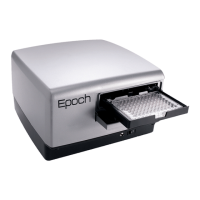Liquid Testing | 33
Liquid Testing
Liquid testing tests the reader in ways that the Absorbance Test Plate cannot. The test
plate will indicate the absolute amount of light absorbed, which will accurately test the
linearity of the electronics. The liquid test will help detect optical defects such as dirt
on the lenses or contamination that can contribute to errant readings.
• If you have the Absorbance Test Plate, you will need to perform only Liquid
Test 1 for routine testing.
• If you do not have the Absorbance Test Plate, you can test the linearity,
repeatability, and alignment of the reader by performing Liquid Test 2.
• BioTek offers a dye solution (PN 7120779, 25 mL; or 7120782, 125 mL) that can
be used in the stock solution formulation for Liquid Tests 1 and 2, or, if you
prefer, you may use the dye solution described in Table 2 on page 35. The
purpose of the formulation is to create a solution that absorbs light in a well-
defined manner at ~2.000 OD full strength when dispensed at 200 µL in a flat-
bottom microplate well.
• Alternatively, any solution that gives a stable color will suffice. (This includes
substrates incubated with an enzyme preparation and then stopped with an
acidic or basic solution.) Some enzyme/substrate combinations that may be
used as alternates to the described dye are shown in Table 1 below.
• If you must test the reader’s performance at 340 nm, perform the optional
Liquid Test 3 (see page 19).
Table 1
Typical Enzyme-Substrate Combinations and Stopping Solutions
Enzyme Substrate Stopping Solution
Alkaline Phosphate o-nitrophenyl phosphate 3N sodium hydroxide
beta-Galactosidase o-nitrophenyl -beta-D
galactopyranoside
1M sodium carbonate
Peroxidase 2,2'-Azino di-ethylbenzothiazoline-
sulfonic acid (ABTS)
citrate-phosphate buffer,
pH 2.8
Peroxidase o-phenylenediamine 0.03N sulfuric acid
Epoch Operator’s Manual

